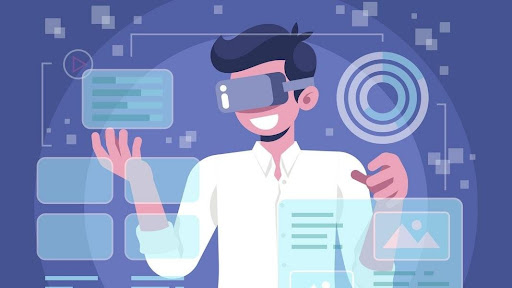Маркетинг в сфере AR и VR: Как дополненная и виртуальная реальность меняют подходы к продвижению
VR и AR это
VR (виртуальная реальность) и AR (дополненная реальность) представляют собой две инновационные технологии, которые внесли революцию в способы взаимодействия человека с информацией и окружающим миром. Они создают среду, где реальность смешивается с виртуальными элементами, но в то же время эти технологии различаются по своему функционалу и воздействию на пользователя.
Виртуальная реальность (VR) погружает человека в полностью виртуальное окружение, изолируя его от реального мира. Пользователь надевает специальный VR-шлем или очки, которые полностью заменяют его видение реальности на виртуальный мир. Это создает исключительно иммерсивный опыт, где пользователь чувствует себя, как будто находится внутри созданного компьютером мира.
Дополненная реальность (AR), напротив, обогащает реальное окружение пользователя виртуальными объектами или информацией. Вместо полной изоляции от реальности, AR использует камеры устройства (как правило, смартфона или планшета) для добавления виртуальных элементов поверх изображения реального мира. Это позволяет пользователям видеть и взаимодействовать с виртуальными объектами, сохраняя связь с окружающей средой.
Технологии AR и VR для бизнеса
И AR, и VR имеют потенциал изменить подходы к бизнесу и маркетингу. Давайте рассмотрим, как они применяются в сфере предпринимательства.
AR для бизнеса
- Расширенный опыт покупки: ритейлеры могут использовать AR для создания виртуальных примерочных или отображения товаров в реальной среде. Например, клиенты могут примерить виртуальную одежду перед покупкой.
- Улучшенное обучение и обслуживание: AR может быть применена для обучения персонала или предоставления интерактивной поддержки клиентам. Это особенно полезно в сфере обслуживания клиентов.
- Интерактивный маркетинг: AR-фильтры в социальных сетях (например, Snapchat и Instagram) позволяют пользователям взаимодействовать с брендами через веселые и креативные фильтры.
VR для бизнеса
- Виртуальные туры и мероприятия: компании могут организовывать виртуальные туры по своим объектам или проводить мероприятия в виртуальных мирах, привлекая широкую аудиторию.
- Обучение и тренировки: VR идеально подходит для симуляций и тренировок, особенно в сферах, где требуется высокая степень иммерсии, например, в медицине или авиации.
- Продуктовая демонстрация: виртуальная реальность позволяет демонстрировать продукты и услуги в контролируемой и интересной среде, что может сделать продажу более эффективной.
Кейсы успешных компаний
Давайте рассмотрим несколько примеров компаний, которые успешно используют AR и VR в маркетинге.
IKEA
Известная мебельная компания IKEA создала приложение IKEA Place, позволяющее пользователям поместить виртуальную мебель в свои дома с помощью AR. Это дает покупателям возможность увидеть, как мебель будет выглядеть в их интерьере, прежде чем они сделают покупку.
Red Bull
Red Bull создала VR-приложение, позволяющее пользователям испытать ощущения гонщика Формулы 1. Это позволяет бренду Red Bull углубить взаимодействие с аудиторией и создать более эмоциональную связь.
Volkswagen
Volkswagen использует VR для создания виртуальных тест-драйвов своих автомобилей. Потенциальные клиенты могут испытать машину в разных условиях без фактической поездки к дилеру.
Идеи для маркетинга в AR и VR
Использование AR и VR в маркетинге предоставляет огромный простор для креативных идей и уникальных кампаний. Виртуальная и дополненная реальность могут стать мощными инструментами для привлечения внимания и взаимодействия с аудиторией.
Одной из идей является создание интерактивных каталогов продуктов, где потенциальные клиенты смогут взаимодействовать с товарами перед покупкой. Также можно организовывать виртуальные мероприятия, привлекая широкую аудиторию и создавая незабываемые впечатления.
В области обучения и тренингов AR и VR могут использоваться для создания интерактивных обучающих программ. Важно также не забывать о создании уникальных и креативных VR-продуктовых демонстраций, чтобы продемонстрировать товары и услуги в интересной виртуальной среде. Эти идеи позволят компаниям улучшить маркетинговую стратегию и усилить взаимодействие с клиентами в мире VR и AR.
Будущее маркетинга в сфере AR и VR
С появлением более доступных устройств и увеличением количества контента, маркетологи получат еще больше возможностей для взаимодействия с аудиторией.
Инновации в области искусственного интеллекта и машинного обучения также сделают AR и VR более персонализированными и адаптированными к индивидуальным потребностям потребителей.
Итак, технологии дополненной и виртуальной реальности в маркетинге открывают двери к бескрайним возможностям. Они позволяют компаниям создавать уникальные и интерактивные кампании, улучшать взаимодействие с аудиторией и предоставлять клиентам незабываемые впечатления. В мире, где внимание потребителей стоит на вес золота, использование технологий дополненной и виртуальной реальности в маркетинге становится ключевым элементом успешной стратегии. Будущее этой области обещает еще больше инноваций и удивительных возможностей для бизнеса.
Эксперт в области интернет-маркетинга. Руководитель маркетингового агентства MAVR.
Бизнес-степень «Мастер делового администрирования» (MBA).


